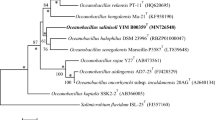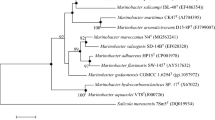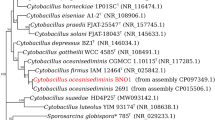Abstract
A novel bacterium, designated strain APA_H-1(4)T, was isolated from the saline−alkaline soil, Zhaodong, Heilongjiang Province, China. Phenotypic and chemotaxonomic analyses, and whole-genome sequencing were used to determine the taxonomic position of the strain. Phylogenetic analysis indicated that the isolate belongs to the genus Oceanobacillus, and showed the highest sequence similarity to O. damuensis KCTC 33146T (98.35%, similarity) and ‘O. massiliensis’ DSM 24644 (98.32%). The average nucleotide identity values between strain APA_H-1(4)T and other members of the genus Oceanobacillus were lower than 82% recommended for distinguishing novel prokaryotic species. The digital DNA−DNA hybridization values of strain APA_H-1(4)T with O. damuensis KCTC 33146T and ‘O. massiliensis’ DSM 24644 were 13.60 and 17.60%, respectively. Cells of strain APA_H-1(4)T were Gram-staining positive, motile, aerobic, spore-forming rods (0.5–0.7 × 1.8–2.6 μm) with flagella. The growth was found to occur optimally at 37 °C. The whole-cell hydrolysate contained meso-diaminopimelic acid as the diagnostic cell wall diamino acid. The main detected polar lipids consisted of diphosphatidylglycerol, phosphatidylglycerol, an unidentified phospholipid and an unidentified polar lipid. The predominant respiratory quinone was identified as menaquinone-7 (MK-7). The major cellular fatty acid (>10%) was anteiso-C15:0. The G + C content of the genomic DNA was determined to be 38.4% based on the draft genome sequence. Based on the comparative analysis of polyphasic taxonomic data, strain APA_H-1(4)T represents a novel species of the genus Oceanobacillus, for which the name Oceanobacillus saliphilus sp. nov. is proposed. The type strain is APA_H-1(4)T (=GDMCC 1.2239T = KCTC 43254T).


Similar content being viewed by others
References
Lu J, Nogi Y, Takami H (2001) Oceanobacillus iheyensis gen. nov., sp. nov., a deep-sea extremely halotolerant and alkaliphilic species isolated from a depth of 1050 m on the Iheya Ridge. FEMS Microbiol Lett 205:291–297
Ouyang YC, Xiang WZ, Wang GH (2015) Oceanobacillus bengalensis sp. nov., a bacterium isolated from seawater of the Bay of Bengal. Antonie Van Leeuwenhoek 108:1189–1196
Raats D, Halpern M (2007) Oceanobacillus chironomi sp. nov., a halotolerant and facultatively alkaliphilic species isolated from a chironomid egg mass. Int J Syst Evol Microbiol 57:255–259
Long XF, Ye RY, Zhang S, Liu B, Zhang YQ, Zeng Z, Tian YQ (2015) Oceanobacillus damuensis sp. nov. and Oceanobacillus rekensis sp. nov., isolated from saline alkali soil samples. Antonie Van Leeuwenhoek 108:731–739
Zhu WY, Yang L, Shi YJ, Mu CG, Wang Y, Kou YR, Yin M, Tang SK (2020) Oceanobacillus halotolerans sp. nov., a bacterium isolated from salt lake in Xinjiang province, north-west China. Arch Microbiol 202:1545–1549
Hirota K, Aino K, Nodasaka Y, Yumoto I (2013) Oceanobacillus indicireducens sp. nov., a facultative alkaliphile that reduces an indigo dye. Int J Syst Evol Microbiol 63:1437–1442
Yumoto I, Hirota K, Nodasaka Y, Nakajima K (2005) Oceanobacillus oncorhynchi sp. nov., a halotolerant obligate alkaliphile isolated from the skin of a rainbow trout (Oncorhynchus mykiss), and emended description of the genus Oceanobacillus. Int J Syst Evol Microbiol 55:1521–1524
Jiao JY, Liu L, Hua ZS, Fang BZ, Zhou EM, Salam N, Hedlund BP, Li WJ (2021) Microbial dark matter coming to light: challenges and opportunities. Natl Sci Rev 8:nwaa280
Jiao JY, Fu L, Hua ZS, Liu L, Salam N, Liu PF, Lv AP, Wu G, Xian WD, Zhu Q, Zhou EM, Fang BZ, Oren A, Hedlund BP, Jiang HC, Knight R, Cheng L, Li WJ (2021) Insight into the function and evolution of the Wood-Ljungdahl pathway in Actinobacteria. ISME J 15:3005–3018
Marcy Y, Ouverney C, Bik EM, Lösekann T, Ivanova N, Martin HG, Szeto E, Platt D, Hugenholtz P, Relman DA, Quake SR (2007) Dissecting biological “dark matter” with single-cell genetic analysis of rare and uncultivated TM7 microbes from the human mouth. Proc Natl Acad Sci USA 104(29):11889–11894
Hyun DW, Whon TW, Kim JY, Kim PS, Bae JW (2015) Genomic analysis of the moderately haloalkaliphilic bacterium Oceanobacillus kimchii strain x50(t) with improved high-quality draft genome sequences. J Microbiol Biotechnol 25(12):1971–1976
Hagaggi N (2020) Studies on the extremo-lipase produced by the halotolerant Oceanobacillus iheyensis strain QCS. Novel Res Microbiol J 4(4):907–920
Kavita K, Singh VK, Mishra A, Jha B (2014) Characterisation and anti-biofilm activity of extracellular polymeric substances from Oceanobacillus iheyensis. Carbohyd Polym 101:29–35
Wang S, Sun L, Wei D, Salam N, Fang BZ, Dong ZY, Hao XY, Zhang MY, Zhang Z, Li WJ (2021) Nesterenkonia haasae sp. nov., an alkaliphilic actinobacterium isolated from a degraded pasture in Songnen Plain. Arch Microbiol 203:959–966
Roux V, Million M, Robert C, Magne A, Raoult D (2013) Non-contiguous finished genome sequence and description of Oceanobacillus massiliensis sp. nov. Stand Genomic Sci 9:370–384
Li WJ, Xu P, Schumann P, Zhang YQ, Pukall R, Xu LH, Stackebrandt E, Jiang CL (2007) Georgenia ruanii sp. nov., a novel actinobacterium isolated from forest soil in Yunnan (China) and emended description of the genus Georgenia. Int J Syst Evol Microbiol 57:1424–1428
Yoon SH, Ha SM, Kwon S, Lim J, KimY SH, Chun J (2017) Introducing EzBioCloud: a taxonomically united database 16S rRNA and whole genome assemblies. Int J Syst Evol Microbiol 67:1613–1617
Thompson JD, Higgins DG, Gibson TJ (1994) CLUSTAL W: improving the sensitivity of progressive multiple sequence alignment through sequence weighting, position-specifc gap penalties and weight matrix choice. Nucleic Acids Res 22:4673–4680
Kumar S, Stecher G, Li M, Knyaz C, Tamura K (2018) MEGA X: molecular evolutionary genetics analysis across computing platforms. Mol Biol Evol 35(6):1547–1549
Saitou N, Nei M (1987) The neighbor-joining method: a new method for reconstructing phylogenetic trees. Mol Biol Evol 4:406–425
Tamura K, Nei M (1993) Estimation of the number of nucleotide substitutions in the control region of mitochondrial DNA in humans and chimpanzees. Mol Biol Evol 10:512–526
Nei M, Kumar S (2000) Molecular evolution and phylogenetics. Oxford University Press, New York
Felsenstein J (1985) Confidence limits on phylogenies: an approach using the bootstrap. Evolution 39:783–791
Parks DH, Imelfort M, Skennerton CT, Hugenholtz P, Tyson GW (2015) CheckM: assessing the quality of microbial genomes recovered from isolates, single cells, and metagenomes. Genome Res 25(7):1043–1055
Pritchard L, Glover RH, Humphris S, Elphinstone JG, Toth KL (2016) Genomics and taxonomy in diagnostics for food security: soft-rotting enterobacterial plant pathogens. Anal Methods 8:12–24
Meier-Kolthof JP, Auch AF, Klenk HP, Göker M (2013) Genome sequence-based species delimitation with confidence intervals and improved distance functions. BMC Bioinform 14:60
Kanehisa M, Sato Y, Kawashima M, Furumichi M, Tanabe M (2016) KEGG as a reference resource for gene and protein annotation. Nucleic Acids Res 44:D457-462
Seemann T (2014) Prokka: rapid prokaryotic genome annotation. Bioinformatics 30(14):2068–2069
Murray RG, Doetsch RN, Robinow CF (1994) Determinative and cytological light microscopy. In: Gerhardt P, Murray RG, Wood WA, Krieg NR (eds) Methods for general and molecular bacteriology. American Society for Microbiology, Washington DC, pp 21–41
Baron EJ, Finegold SM (1990) Bailey and Scott’s diagnostic microbiology, 8th edn. Mosby, St. Louis
Xu P, Li WJ, Tang SK, Zhang YQ, Chen GZ, Chen HH, Xu LH, Jiang CL (2005) Naxibacter alkalitolerans gen. nov., sp. nov., a novel member of the family ‘Oxalobacteraceae’ isolated from China. Int J Syst Evol Microbiol 55:1149–1153
Smibert R, Krieg NRM (1994) Phenotypic characterization. In: Gerhardt P, Murray RG, Wood WA, Krieg NR (eds) Methods for general and molecular bacteriology. American Society for Microbiology, Washington DC, pp 607–654
Lechevalier MP, Lechevalier HA (1970) Chemical composition as a criterion in the classification of aerobic actinomycetes. Int J Syst Bacteriol 20:435–443
Hasegawa T, Takizawa M, Tanida S (1983) A rapid analysis for chemical grouping of aerobic actinomycetes. J Gen Microbiol 29:319–322
Minnikin DE, O’Donnell AG, Goodfellow M, Alderson G, Athalye M, Schaal A, Parlett JH (1984) An integrated procedure for the extraction of bacterial isoprenoid quinones and polar lipids. J Microbiol Methods 2:233–241
Collins MD, Jones D (1980) Lipids in the classification and identification of coryneform bacteria containing peptidoglycans based on 2, 4-diaminobutyric acid. J Appl Bacteriol 48:459–470
Minnikin DE, Collins MD, Goodfellow M (1979) Fatty acid and polar lipid composition in the classification of Cellulomonas, Oerskovia and related taxa. J Appl Bacteriol 47:87–95
Collins MD, Pirouz T, Goodfellow M, Minnikin DE (1977) Distribution of menaquinones in actinomycetes and corynebacteria. J Gen Microbiol 100:221–230
Tamaoka J, Katayama-Fujimura Y, Kuraishi H (1983) Analysis of bacterial menaquinone mixtures by high performance liquid chromatography. J Appl Bacteriol 54:31–36
Empadinhas N, Costa MS (2008) Osmoadaptation mechanisms in prokaryotes: distribution of compatible solutes. Int Microbiol 11:151–161
Ventosa A, Nieto JJ, Oren A (1998) Biology of moderately halophilic aerobic bacteria. Microbiol Mol Biol Rev 62(2):504–544
Funding
This research was supported by the National Key Research and Development Program of China (2021YFD1500300) and the National Science and Technology Fundamental Resources Investigation Program of China (2021FY100900). WJL and SW were also supported by Introduction project of high-level talents in Xinjiang Uygur Autonomous Region.
Author information
Authors and Affiliations
Contributions
WJL, SW and LXC designed the research and project outline. SW isolated the bacterium. JYJ and LL performed the genomic data analysis. YTOY, MML, APL and ZTL performed the deposition, physiological and chemotaxonomic experiments. YTOY drafted the manuscript. All authors have read and approved the final version of the manuscript.
Corresponding authors
Ethics declarations
Conflict of interest
The authors declare that there are no conflicts of interest.
Ethical Approval
This article does not contain any studies with human participants or animals performed by any of the authors.
Additional information
Publisher's Note
Springer Nature remains neutral with regard to jurisdictional claims in published maps and institutional affiliations.
Supplementary Information
Below is the link to the electronic supplementary material.
Rights and permissions
Springer Nature or its licensor holds exclusive rights to this article under a publishing agreement with the author(s) or other rightsholder(s); author self-archiving of the accepted manuscript version of this article is solely governed by the terms of such publishing agreement and applicable law.
About this article
Cite this article
OuYang, YT., Li, MM., Lv, AP. et al. Oceanobacillus saliphilus sp. nov., Isolated from Saline−Alkali Soil in Heilongjiang Province, China. Curr Microbiol 79, 301 (2022). https://doi.org/10.1007/s00284-022-02997-0
Received:
Accepted:
Published:
DOI: https://doi.org/10.1007/s00284-022-02997-0




